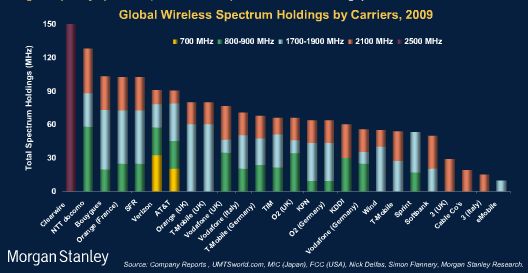Verizon Launching LTE Dec 5
Posted by Sam Churchill on December 1st, 2010Verizon Wireless today announced it plans to turn on their 4G LTE network this Sunday, Dec. 5. Verizon’s 700 MHz, 4G LTE network isn’t the first LTE network in the United States — but it is the biggest. Verizon will initially launch LTE service in 38 major metropolitan areas and in more than 60 commercial airports coast to coast.
Street level coverage area maps will be available online on Dec. 5. Today, customers can go to www.verizonwireless.com/4Glte to check if their addresses will be in the initial 4G LTE coverage area.
Two 4G LTE Mobile Broadband data plans were announced. A $50 (5 GB monthly allowance) and an $80 (10 GB monthly allowance) plan. Both have $10/GB overage fees.
Two LTE dongles for laptops were announced. The LG VL600 is available at launch while the Pantech UML 290 will be available soon, each $99.99 after $50 rebate with a new two-year agreement. Both USB modems provide will automatically fallback to the company’s 3G network outside of 4G coverage. The company expects consumer-oriented handsets will be available by mid-2011.
The company expects 4G LTE average data rates in real-world, loaded network environments to be 5 to 12 megabits per second (Mbps) on the downlink and 2 to 5 Mbps on the uplink.
Verizon selected Ericsson and Alcatel-Lucent as primary network vendors for its initial LTE network deployments, while Starent Networks (now owned by Cisco) provides the packet core.
AT&T’s Chief Technology Officer, John Donovan, says their HSPA+ network is expected to deliver speed performance similar to initial LTE deployments.
“That matters, because when we begin commercial deployment of LTE in mid 2011, customers on our LTE network will be able to fall back to HSPA+. As they do, they’ll receive a more consistent mobile broadband experience that supports simultaneous voice and data connections and higher speeds than the others can provide outside their LTE footprint.”
Eighty percent of AT&T’s mobile network has been upgraded to HSPA+, CTO John Donovan. AT&T expects to cover 250 million POPs with HSPA+ by year-end and plans to launch LTE service by the middle of next year, covering 70-75 million POPs with LTE by the end of 2011.
But so far, AT&T has only said that it will deploy a 14.4Mbit/s upgrade by the end of this year, revealing nothing about any 21Mbit/s upgrade in 2011, notes Light Reading.
By contrast, T-Mobile plans to cover 100 markets and 200 million POPs with a 21Mbit/s HSPA+ upgrade for 100 cities by year-end, reports Fierce Wireless. T-Mobile claims typical download speeds on par with or faster than competing 4G technologies, with service availability in 75 metropolitan markets throughout the United States. The average download speeds on 21Mbit/s HSPA+ are reportedly in the 5 to 8 Mbit/s range, similar to “4G” speeds offered by Clear’s WiMAX.
CLEAR 4G service is currently available in 68 markets across the United States and expects to cover some 120 million people by the end of the year.
Clear offers their own comparison of their 2.6 GHz WiMAX vrs Verizon’s 700 Mhz LTE debate. While it’s too early to compare performance in typical use, the 700 MHz Verizon system is likely to penetrate better indoors and may provide more uniform service around town. Clear’s 2.6 GHz WiMAX could be spottier but faster.
Engadget has the best “4G” comparison chart yet (below), although the subtleties of 3G/4G handover, the difference between AT&T’s and T-Mobile’s HSPA+, coverage, and overage fees could be important factors.
It’s like voice – the carrier with the best service in the areas you need is the best.
The cost difference between WiMAX and LTE can be significant. Clear has replaced my DSL because it offers unlimited internet access (for $40/mo). Verizon’s $80/mo service (for 10 Gigs month), would limit my NetFlix viewing. In November, for example, I pushed over 32 Gigs through my Clear WiMAX dongle. If I were using Verizon’s LTE dongle, the same usage would have cost me $80 (for 10 GB), plus $10 x 22GB in overage fees (at $10/GB for overage fees). That’s $80 + $220, or $300/month – a huge difference.
For me, WiMAX was always a no-brainer, since I stick pretty close to home. My WiMAX dongle provides mobile WiFi for my smartphone. Mobile users probably don’t need more than 5-10 GB per month. They may prefer LTE due to its better penetration (and eventually) better coverage. Both AT&T and T-Mobile have good arguments about their HSPA+ networks being faster than Verizon’s plain vanilla CDMA, however.
If you do go with LTE (or any cellular carrier for that matter), don’t plan on dropping DSL or Cable Modem service. It’s just not cost/effective as a wire replacement.
Both Verizon and AT&T are rolling out nationwide LTE service at 700 MHz, Sprint and Clearwire may use their 2.6 GHz spectrum for LTE, and satphone companies are now looking to partner. So what have we got?
- Nationwide LTE networks from Verizon and AT&T (700MHz)
- Nationwide HSPA+ network from T-Mobile using AWS (1.7/2.1 GHz)
- Nationwide WiMAX network from Sprint/Clearwire (2.6 GHz)
- Potential nationwide satphone/terrestrial service from Lightsquared (1.6 GHz)
- Potential nationwide cable LTE network using SpectrumCo (AWS) licenses
What we have is an industry in flux. It should be interesting.
source: dailywireless.org












No comments:
Post a Comment